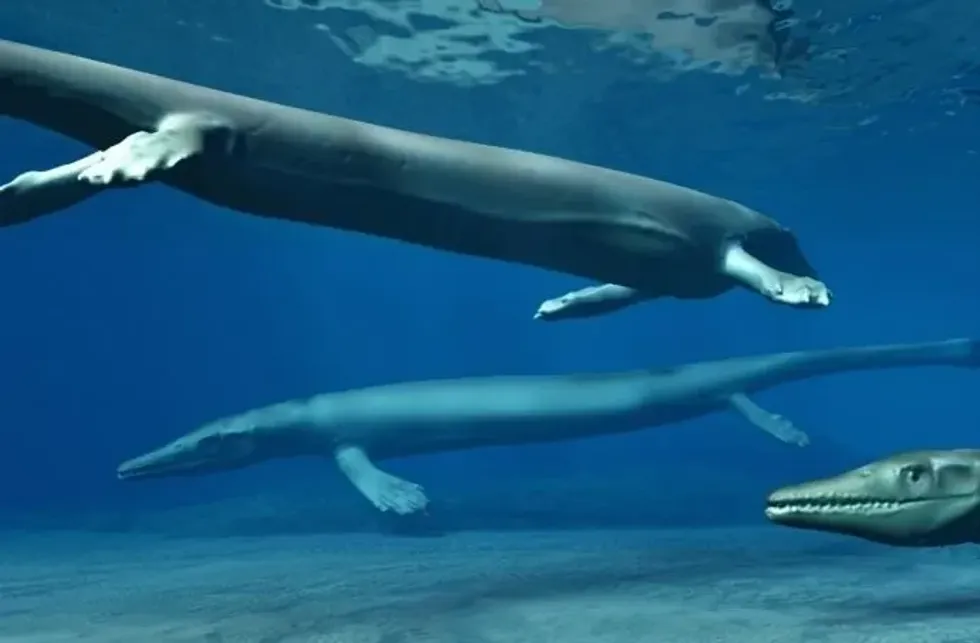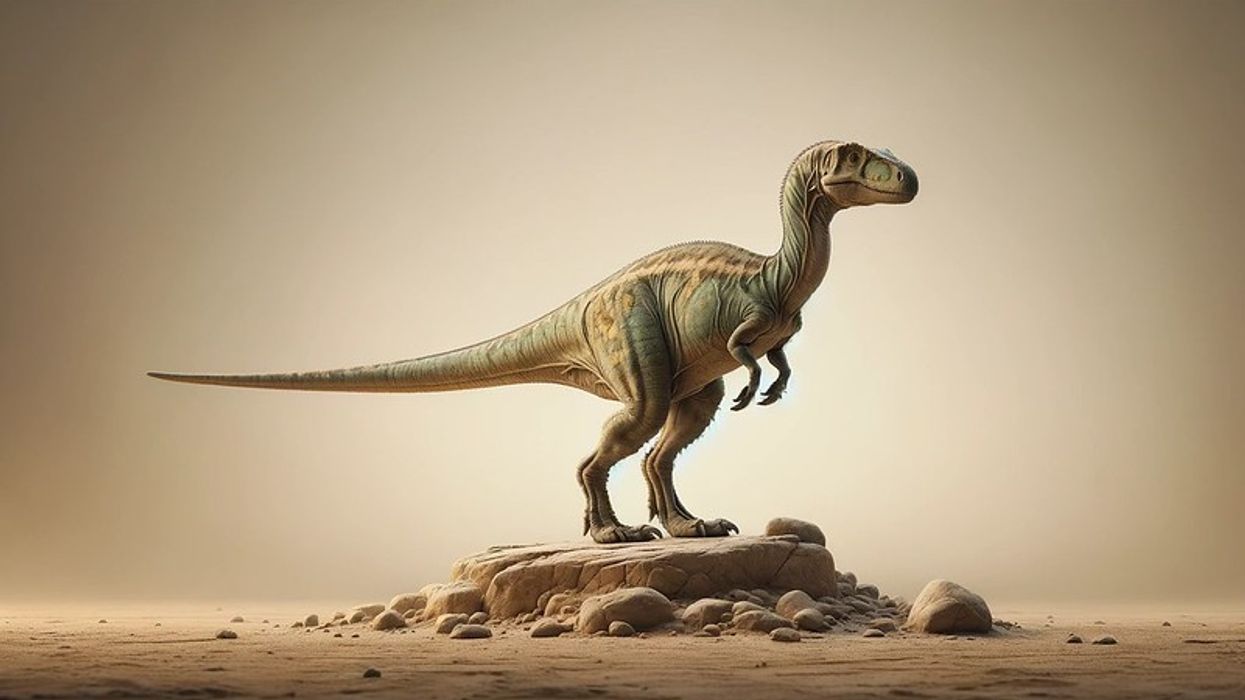Clidastes is classified as a mosasaur, and the type species is referred to as Clidastes propython. The specimen was found in Alabama, North America.
Apart from North America, some other specimens of mosasaurs were found in Russia, Sweden, Germany, Mexico, and Jordan. It was known to inhabit marine habitats. Reproduction of this reptile took place through a sexual process just like other reptiles and either it laid eggs or gave birth to live young.
This mosasaur was known to have a slim and delicate form with extended neural spines and chevrons near the tail tip. The neck was short and the body and tail were long.
The limbs were known to terminate in broad appendages. There was a high positioning bone on the coronoid posterior region. It might have had a heavy dorsal crest.
The teeth were sharp, curved, and pointed. There were 14-16 teeth in the pterygoid and 16-18 teeth in the dentary. The small rostrum might have been anterior to the premaxilla and it had an interdental ridge on the dorsal part of the dentary.
The teeth of the mosasaur were quite uniform with some exceptions. The diet of the mosasaurs was known to be carnivorous and their food consisted of fishes, cephalopods, and other small vertebrates found in the shallow water.
The remains of Clidastes ranged from the Coniacian to the Early Campanian in the age in the United States. These extinct reptiles were known to be agile swimmers.
The specimen of the type species, C. propython that were collected were of a juvenile and were considered to be one of the best-preserved and complete ones. This type differed from other mosasaurs based on the cervical vertebrates.
The length of C. liodontus is slightly different as recorded when studied the collected specimen from the Smoky Hill Chalk Niobrara Formation.
A frontal portion of the mosasaur, Clidastes propython (from the order and family Squamata, Mosasauridae, respectively), has also been found in the Rybushka Formation of the Upper Cretaceous, Campanian age. Some parts are known to have been stored in the Museum of Natural History.
It is very interesting to learn about these reptiles and if you like, read about Ornithosuchus and Longisquama, too.
Clidastes Interesting Facts
Was the Clidastes a dinosaur?
No, Clidastes was not a dinosaur, it was a mosasaur that lived at the same time as the dinosaurs.
How do you pronounce 'Clidastes'?
Clidastes is pronounced as 'cli-dest-es'.
What type of prehistoric reptile was a Clidastes?
It was classified as a mosasaur.
In which geological period did the Clidastes live?
It is known to have lived in the Late Cretaceous age.
When did the Clidastes become Extinct?
The exact time period of extinction of this species is not known.
Where did the Clidastes live?
It is known to have inhabited North America.
What was a Clidastes' habitat?
While not many details are available about the habitat of this reptile, but it is believed that it used to inhabit marine habitats, such as oceans and seas.
Who did the Clidastes live with?
It is not known if this mosasaur lived in groups or was a solitary creature.
How long did a Clidastes live?
The lifespan of this reptile is unknown.
How did they reproduce?
Reproduction took place just like other reptiles, but there have been two possibilities stated; one that is used to lay eggs, and the other that birth is given to a live young.
Clidastes Fun Facts
What did a Clidastes look like?

Based on the studied type specimen of a Clidastes skeleton, it had a slender and delicate form with an extension of the neural spines and chevrons near the tail tip. The neck was known to be short and the body and tail were long and slim.
The limbs used to terminate in broad appendages, this helped this animal with directional control.
Various features of Clidastes jaw are known, there were around 14-18 teeth in the maxilla. These teeth were known to be sharply pointed and curved.
The parietal foramen was small and was located within the parietal. There was a high positioning bone on the coronoid posterior surface. It might have had a heavy dorsal crest.
It is believed that the small rostrum was anterior to the premaxilla. There were 14-16 teeth in the pterygoid and 16-18 teeth in the dentary.
The teeth of the mosasaur were quite uniform with some exceptions. The enamel surface was known to be smooth. There is an interdental ridge on the dorsal part of the dentary.
How many bones did a Clidastes have?
The number of bones that this Mosasaurus had is unknown.
How did they communicate?
Communication is thought to have taken place through sounds, gestures, and postures and sometimes, through chemical cues, too.
How big were the Clidastes?
The size is around 6.6-13 ft (2-4 m) in length.
How fast could a Clidastes move?
The exact moving speed of mosasaurs is not known.
How much did Clidastes weigh?
No information is available about the weight of this mosasaur.
What were the male and female names of the species?
Males and females did not have any sex-specific names.
What would you call a baby Clidastes?
A baby Clidastes was referred to as a juvenile.
What did they eat?
The diet of this mosasaur species was carnivorous and it fed on fishes, cephalopods, and other small vertebrates that were found in the shallow waters.
How aggressive were they?
This species was considered to be aggressive, but it is quite difficult to determine the exact aggressiveness of this species.
Did you know...
It was a marine lizard.
Clidastes are known and studied from deposits that ranged from the Coniacian to the Early Campanian age in the present-day United States.
The name Clidastes is known to mean 'locked vertebrae' and has its origin in the Greek 'kleid' which means 'key' which is similar to Latin 'claudere' which means to 'shut'.
It is known to be one of the first or earliest hydropedal mosasaurs which properly represents marine predatory forms.
It was known to be an agile swimmer.
It was considered to be one of the smallest of all the known mosasaurs. The smallest of them is Dallasaurus.
Clidastes and other mosasaurs, along with snakes, are known to have the thecodont tooth implantation in common and also the recumbent position of the replacement teeth but the development of the replacement teeth in both the animals is different.
Some specimens of this mosasaur were found in Russia, Sweden, Germany, Mexico, and the Maastrichtian of Jordan in the past, but it is believed that it was questioned if the specimen discovered and preserved actually belonged to this genus as it was quite fragmentary.
It has been recorded that it was E. D. Cope who discovered the specimen Clidastes propython from the Mooreville Chalk, Lowndes County, Alabama in 1869.
The remains that were discovered were of a juvenile and were considered to be the most complete and the best-preserved mosasaurs specimen that has been found and it is considered to be the generic holotype of the Clidastes.
Charles H. Sternberg and his son had also discovered some more remains of this mosasaur in Kansas and were surprised to find that this mosasaur had humeri and femora with round heads, just like mammals.
It has been recorded that the cervical vertebrae of the Clidastes were quite different from the other mosasaurs as it was more elongated.
It is also considered to be one of the most basal mosasaurines and also the most basal hydropedal mosasaurine.
It is stated to be more derived as compared to the Dallasaurus and lesser than the later genera like Globidens and Prognathodon.
There is only one species named for the Clidastes that is valid, that is, Clidastes propython.
It has been recorded that a species named Clidastes iguanavus Cope in 1868 was considered to be the original type species, but after the petition, IUCN made C. propython the type species based on the species being known from the diagnostic remains.
There is known to be another undescribed type species from the Mooreville Chalk Formation, Alabama which is known to represent its own taxonamy and is referred to as Clidastes moorevillensis and can be differentiated from Clidastes liodontus and C. propython based on its dental characteristics.
The length of Clidastes liodontus from the Smoky Hill Chalk Formation is slightly smaller than that of C. propython.
A frontal portion of the mosasaur, Clidastes propython (from the order and family Squamata, Mosasauridae, respectively) has also been found in the Rybushka Formation of the Upper Cretaceous, Campanian age.
It has been stated that according to some evidence, the first records of Clidastes were from Europe.
Why is it called Clidastes?
'Clidastes' means locked vertebrae and originated from Greek. The name is based on the fact that the vertebral processes of this mosasaur allow the proximal heads to interlock while swimming for strength and stability.
How many specimens of Clidastes were discovered?
The exact number of specimens that have been discovered for this species is not known.
Here at Kidadl, we have carefully created lots of interesting family-friendly prehistoric animal facts for everyone to discover! Learn more about some other creatures from our Nothosaurus interesting facts, or Ornithosuchus facts for kids.
You can even occupy yourself at home by coloring in one of our free printable Clidastes coloring pages.
Main image by Nobu Tamura.
Second image by Ryan Somma.










